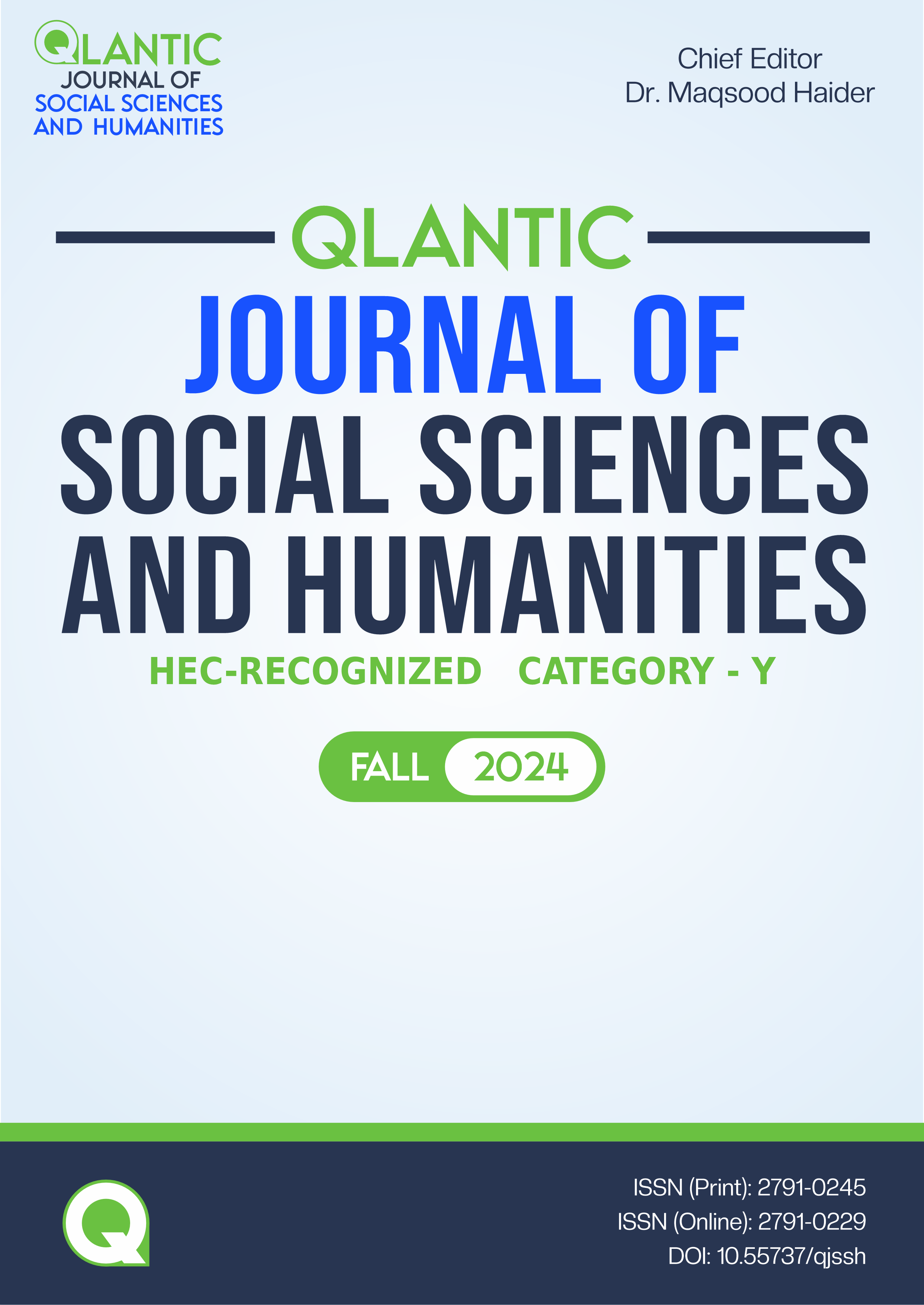An Exploration of Sociodemographic Determinants to Accessing Justice from a Socio-legal Approach
DOI:
https://doi.org/10.55737/qjssh.v-iv.24266Keywords:
Sociodemographic, Determinants, Accessing Justice, Socio-legal Approach, ExplorationAbstract
Sociodemographic variables are knowable and provide information on the individual's social, economic, and personal position. Access to justice has not always remained uniform; it has been subjective to various factors, including the sociodemographic of the litigants. This study examined popular sociodemographics as the determinant of justice accessibility from a socio-legal approach. The study used a quantitative methodology and cross-sectional design. It was exploratory and descriptive in type. 547 district court litigants in Karachi, Sindh, Pakistan participated in this study. A survey method was used to collect the data on a closed-ended questionnaire, which was analyzed by applying IBM SPSS version 22. Overall, the study rendered important empirical results and revealed that sociodemographic indicators are related to justice accessibility, except for one religious affiliation. Additionally, the study identified a weak socioeconomic status of the litigants. The study concluded that sociodemographic variables are the factors that determine the justice accessibility of an individual. Justice accessibility can be increased by improving the socioeconomic conditions of the litigants and conducting more studies on a larger scale to understand the relationship of sociodemographics with access to justice.
References
Adongo, A. A., Dapaah, J. M., & Azumah, F. D. (2023). Gender and Access to Justice in the Informal Court System in Ghana: A Descriptive Phenomenology in a Patriarchal Society. Current Social Science, 1, 54-68. https://doi.org/10.2174/012772316X277583231229091308
Akarçay, A., & Polat, S. (2023). Reluctance to report criminal incidents: limited access to justice, social exclusion, and gender. European Journal of Law and Economics, 55(1), 145-166. https://doi.org/10.1007/s10657-022-09748-3
Asiamah, N., Mensah, H. K., & Oteng-Abayie, E. F. (2022). Non-probabilistic sampling in quantitative clinical research: A typology and highlights for students and early career researchers. International Journal of Applied Research on Public Health Management (IJARPHM), 7(1), 1-18. http://dx.doi.org/10.4018/IJARPHM.290379
Aubagna, M. (2020, January 14). What are sociodemographic characteristics used for in marketing?. Skeepers. https://skeepers.io/en/blog/socio-demographic-characteristics-marketing/
Banakar, R., & Travers, M. (Eds.). (2005). Theory and method in socio-legal research. Bloomsbury Publishing.
Bermúdez Figueroa, E., Dabetić, V., Yuste, R. P., & Saeidzadeh, Z. (2023). Gender and structural inequalities from a socio-legal perspective. In Gender-competent legal education (pp. 95-142). Cham: Springer International Publishing.
Bilchitz, D. (2017). SocioeconomicSocioeconomic Rights and Expanding Access to Justice in South Africa: What Can Be Done?. In P.Dann, M. Riegner and M. Bönneman (eds). The Global South and Comparative Constitutional Law. http://dx.doi.org/10.2139/ssrn.3759963
Busayo, L. (2024). Sociodemographic: Definition & Examples in Surveys. Formplus. https://www.formpl.us/blog/socio-demographics
Cahoon, K. (2023, December 19). Access to Justice in Rural Communities and the Impact it has on Civil Procedure. https://mbaccesstojustice.ca/access-to-justice-in-rural-communities-and-the-impact-it-has-on-civil-procedure/
Jesús Cala, M., Eva Trigo, M., & Saavedra, F. J. (2016). Women’s disengagement from legal proceedings for intimate partner violence: Sociodemographic and psychological variables. The European Journal of Psychology Applied to Legal Context, 8(1), 35–42. https://doi.org/10.1016/j.ejpal.2015.10.002
Cornford, T. (2016). “The meaning of access to justice”, in E. Palmer, T. Cornford, A. Guinchard and Y. Marique (eds.), Access to Justice: Beyond the Policies and Politics of Austerity, Oxford.
Cotterrell, R. (1997). Socio-legal Studies: Between Policy and Community', Law's Community: Legal Theory in Sociological Perspective, Oxford Socio-Legal Studies. https://doi.org/10.1093/acprof:oso/9780198264903.003.0014
Dahlvik, J., & Pohn-Weidinger, A. (2021). Access to administrative justice and the role of outreach measures: empirical findings on the Austrian Ombudsman Board. International Journal of Law in Context, 17(4), 473-493. https://doi.org/10.1017/S1744552321000501
Du Toit, M. (2021). Language as a Social Determinant of Access to Justice. ESR Review: Economic and Social Rights in South Africa, 22(1), 4-8. https://hdl.handle.net/10520/ejc-esrrev-v22-n1-a2
Fung, E. H. C., & Dong, D. (2024). Access to civil justice as a social determinant of health: a legal epidemiological cross-sectional study. International Journal for Equity in Health, 23(1), 123. https://doi.org/10.1186/s12939-024-02205-4
Gramatikov, M., Kaur, R., Isabella Banks., & Heijstek-Ziemann. K. (2021). Poverty and Access to Justice. The Hague Institute for Innovation of Law. https://www.hiil.org/wp-content/uploads/2021/10/HiiL-report-Poverty-and-Access-to-Justice-web.pdf
Hall, J. A., & Dornan, M. C. (1990). Patient sociodemographic characteristics as predictors of satisfaction with medical care: a meta-analysis. Social science & medicine (1982), 30(7), 811–818. https://doi.org/10.1016/0277-9536(90)90205-7
Hayes, A. (2024). Demographics: How to Collect, Analyze, and Use Demographic Data. Investopedia. https://www.investopedia.com/terms/d/demographics.asp
Islam, M. J., Suzuki, M., & Mazumder, N. (2024). 2024). Promoting access to justice in Bangladesh: Towards a hybrid justice model. International Journal of Law, Crime and Justice, 77, 100655–100655. https://doi.org/10.1016/j.ijlcj.2024.100655
Lapkin, A. (2019). The problems of access to justice in rural areas (on the example of Ukraine). In SHS Web of Conferences (Vol. 68, p. 01018). EDP Sciences.
Lundgren, D. (2023). Inaccessible Justice: A qualitative and quantitative analysis into the Demographics, Socioeconomics, and Experiences of Self Represented Litigants. Litigants. University of Toronto in Partnership with the National Self-Represented Litigants Project. https://scholar.uwindsor.ca/lawnsrlppubs/25
McConville, M. (Ed.). (2017). Research methods for law. Edinburgh University Press.
Mughal, J. R. (2012). Concept of Access to Justice in Pakistan. 2136599. https://papers.ssrn.com/sol3/papers.cfm?abstract_id=2136599
Mule, J. M. (2018). Challenges Facing Women in Accessing Justice in Mbooni Sub-county, Makueni County. [Doctoral dissertation] University of Nairobi.
OECD. (2019). Equal Access to Justice for Inclusive Growth: Putting People at the Centre, OECD Publishing, Paris. https://doi.org/10.1787/597f5b7f-en
Quiceno, M. O., Rueda, W. A. P., & Micán, E. O. C. (2022, June 12-14). SocioeconomicSocioeconomic Factors and Justice. Colombia 2010-2015. 7th North American International Conference on Industrial Engineering and Operations Management, Orlando (pp.1453-1463), Florida, USA. IEOM Society International. https://ieomsociety.org/proceedings/2022orlando/332.pdf
Saboo, K. (n.d.). Data illustrates the sheer impact of improving access to justice. World Bank Group. https://prosperitydata360.worldbank.org/en/stories/2023/data-illustrates-the-sheer-impact-of-improving-access-to-justice
Saleem, A., Mushir, A., Muhammad, S. S., & Iqbal, A. D. (2011). Study on informal justice system in Pakistan Sindh Judicial Academy. Karachi, Pakistan. the Sindh Judicial Academy judges bungalow, (1&2).
Sargisson, R. J., De Groot, J. I., & Steg, L. (2020). The relationship between sociodemographics and environmental values across seven European countries. Frontiers in Psychology, 11, 2253. https://doi.org/10.3389/fpsyg.2020.02253
Snigdha, S. (2023). Socio-Legal Approach to Research. Journal of Legal Studies & Research, 9(5), 5-15. https://jlsr.thelawbrigade.com/article/socio-legal-approach-to-research/
Thoene, U. (2015). A socio-legal exploration of the linkages between informal employment, social protection and labour law in Latin America. revista de estudios Sociales, (54), 12-24. http://dx.doi.org/10.7440/res54.2015.01
Tongco, M. D. C. (2007). Purposive sampling as a tool for informant selection. Ethnobotany Research & Applications 5:147-158. University of Hawaii at Manoa. http://hdl.handle.net/10125/227
Truzzi, B., Lirio, V. S., Cardoso, L. C., Cerqueira, D. R., & Coelho, D. S. (2023). Racial discrimination in access to justice: Evidence from Brazil. International Journal for Crime, Justice and Social Democracy, 12(4), 11-26. http://doi.org/10.5204/ijcjsd.2289
UNDP, H. (2005). Programming for Justice: Access for All. A Practitioner’s Guide to a Human Rights-Based Approach to Access to Justice. Bangkok, Thailand: UNDP.
Watkins, D. (Ed.). (2017). Research methods in law. Routledge.
Waziri, B. A. (2014). SocioeconomicSocioeconomic Factors and Vulnerability of Court Users to Judicial Corruption in Lagos State, Nigeria [Doctoral dissertation]. University of Lagos, Nigeria.
Downloads
Published
Issue
Section
License
Copyright (c) 2024 Muhammad Kamil Lakho, Dr. Ambreen Fazal, Dr. Rana Saba Sultan, Salman Hyder, Rizwan Ali Lakho

This work is licensed under a Creative Commons Attribution-NonCommercial 4.0 International License.





